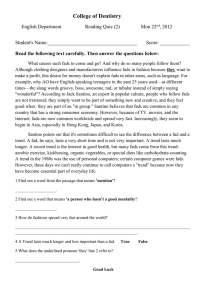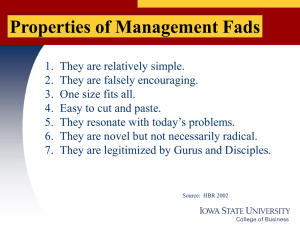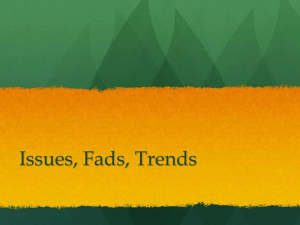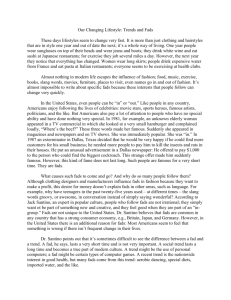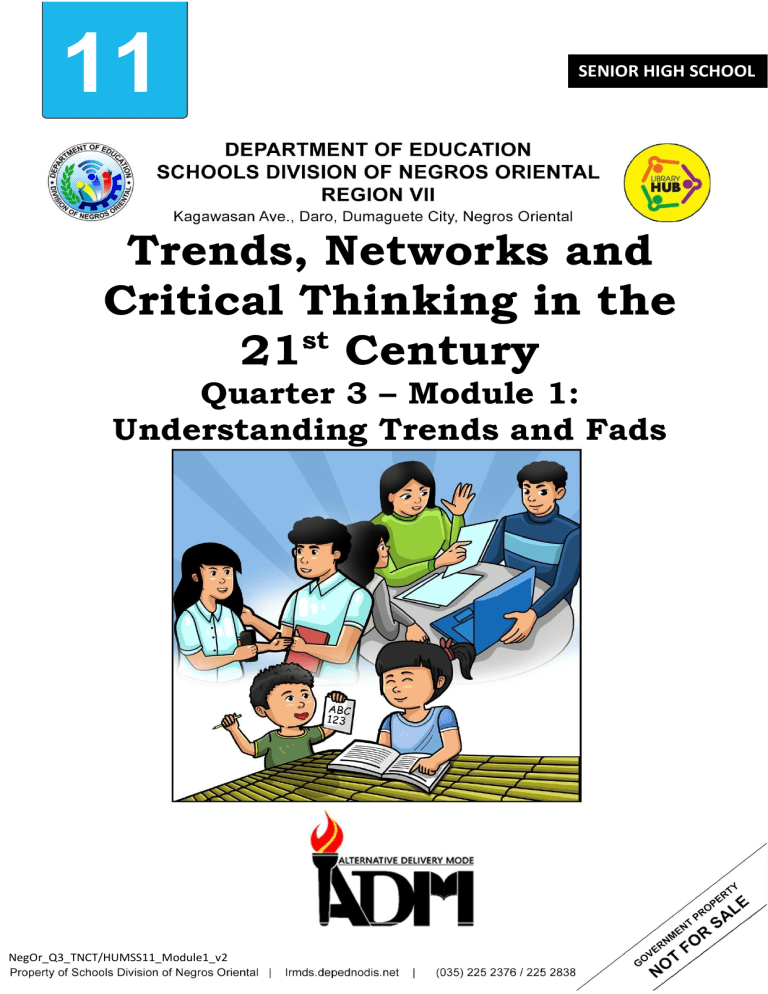
11 SENIOR HIGH SCHOOL Trends, Networks and Critical Thinking in the st 21 Century Quarter 3 – Module 1: Understanding Trends and Fads i NegOr_Q3_TNCT/HUMSS11_Module1_v2 Trends, Networks and Critical Thinking in the 21st Century – Grade 11 Alternative Delivery Mode Quarter 3 – Module 1: Understanding Trends and Fads Second Edition, 2021 Republic Act 8293, section 176 states that: No copyright shall subsist in any work of the Government of the Philippines. However, prior approval of the government agency or office wherein the work is created shall be necessary for exploitation of such work for profit. Such agency or office may, among other things, impose as a condition the payment of royalties. Borrowed materials (i.e., songs, stories, poems, pictures, photos, brand names, trademarks, etc.) included in this module are owned by their respective copyright holders. Every effort has been exerted to locate and seek permission to use these materials from their respective copyright owners. The publisher and authors do not represent nor claim ownership over them. Published by the Department of Education Secretary: Leonor Magtolis Briones Undersecretary: Diosdado M. San Antonio Development Team of the Module Writer: Bryan Miko M. Cadiz Editor: Laurice Kathe T. Inso Reviewer: Divina May S. Medez, Catherine A. Credo Illustrator: Typesetter Layout Artist: Jessie V. Alcala, Enrey P. Alam-alam Management Team: Senen Priscillo P. Paulin, CESO V Rosela R. Abiera Joelyza M. Arcilla EdD Maricel S. Rasid Marcelo K. Palispis EdD Elmar L. Cabrera Nilita L. Ragay EdD Carmelita A. Alcala EdD Printed in the Philippines by ________________________ Department of Education –Region VII Schools Division of Negros Oriental Office Address: Tele #: E-mail Address: Kagawasan, Ave., Daro, Dumaguete City, Negros Oriental (035) 225 2376 / 541 1117 negros.oriental@deped.gov.ph i Introductory Message This Self-Learning Module (SLM) is prepared so that you, our dear learners, can continue your studies and learn while at home. Activities, questions, directions, exercises, and discussions are carefully stated for you to understand each lesson. Each SLM is composed of different parts. Each part shall guide you step-by-step as you discover and understand the lesson prepared for you. Pre-tests are provided to measure your prior knowledge on lessons in each SLM. This will tell you if you need to proceed on completing this module or if you need to ask your facilitator or your teacher’s assistance for better understanding of the lesson. At the end of each module, you need to answer the post-test to selfcheck your learning. Answer keys are provided for each activity and test. We trust that you will be honest in using these. In addition to the material in the main text, Notes to the Teacher are also provided to our facilitators and parents for strategies and reminders on how they can best help you on your home-based learning. Please use this module with care. Do not put unnecessary marks on any part of this SLM. Use a separate sheet of paper in answering the exercises and tests. And read the instructions carefully before performing each task. If you have any questions in using this SLM or any difficulty in answering the tasks in this module, do not hesitate to consult your teacher or facilitator. Thank you. ii What I Need to Know Trends, Networks and Critical Thinking Skills in the 21st Century (TNCT-11) is one of the most essential subjects that Grade 11- Humanities and Social Sciences (HUMSS) learners from take and embrace. With the fast changing world full of wonderful advancements and innovations, it is indeed a necessity for our Filipino students to be well informed regarding these discoveries. Nothing is permanent in this world except change. Hence, it is high time for Filipino students to be GloCal, being both Global and Local thinkers and doers. With the goal of being a globally competitive individual, one should also never forget the importance of local values and thinking strategies that will greatly impact our actions of today’s endeavours. What I Know Directions: Read each statement carefully and write the letter of the correct answer in your activity notebook. 1. Which is true about trend? a. It lasts for a long time. c. It involves innovation and development b. It is short term d. both a and c 2. _________ are objects or behaviors that achieve short-lived popularity but fade away. a. trends b. fads c. innovation d. novelty 3. The following are fundamental elements of trends except ___________. a. basic needs b. innovation c. finances d. drivers of change 4. It is rooted in the fact that people interact with one another in order to survive. a. basic needs b. innovation c. finances d. drivers of change 5. Shifting from one strategy to another to improve the way of life a. basic needs b. innovation c. finances d. drivers of change 1 NEGOR_Q3_TNCT/HUMSS11_MODULE1_V2 6. It is considered as a quick and fast behaviour. a. trend b. fad c. innovation d. novelty 7. ___________ include diets, clothing, hairstyles, toys, and more. a. trend b. fad c. innovation d. novelty 8. Fads often fade quickly when the perception of _______ is gone. a. basic needs b. innovation c. novelty d. drivers of change 9. The secret ingredient of trend is ________, a. its elements b. the tension among the elements c. the drivers of change d. all of these 10. Trends will always be interconnected with _______. a. basic needs b. innovation c. drivers of change d. all of these What’s In The Module 1 of this course will discuss a better way of understanding trends and fads. A comprehensive discussion of the said topics will better equip our Filipino learners with the 21st Century thinking skills that will better prepare them for greater challenges ahead. In this module, you, the learner will understand the emergence of trends and patterns. By the end of this lesson, you are also expected to derive an idea from instances and present this idea through a 50-word essay, artwork, and other graphic representations. 2 NEGOR_Q3_TNCT/HUMSS11_MODULE1_V2 What’s New Before we proceed, what comes to your mind every time you come across with the words trend and fad? Please complete the table below using your activity notebook. Trend Fad 1. 1. 2. 2. 3. 3. What is It (Kiev 2013) Any form of collective behavior that develops within a culture, a generation or social group in which a group of people enthusiastically follow an impulse for a finite period is called a fad, trend, or craze. Objects or behaviors that achieve short-lived popularity but fade away are called Fads. Fads are often sudden, quick-spreading, and short-lived. Example of these are diets, clothing, hairstyles, toys, and more. Throughout history, there are some popular fads like toys: such as yo-yos, hula hoops, and fad dances such as the Macarena and the twist. Fads are similar to habits or customs but less durable. They are often results from an activity or behavior being perceived as emotional. They are often 3 NEGOR_Q3_TNCT/HUMSS11_MODULE1_V2 popular or exciting within a peer group, or being believed "cool" as often promoted by social networks. A fad is said to "catch on" when the number of people adopting it begins to increase to the point of being noteworthy. Fads often fade quickly when the perception of novelty is gone. The Fundamental Trend Elements There are three fundamental elements that drive all trends: (Dumitrescu n.d.) The secret ingredient of trends however isn’t actually any of one of these elements. Rather, it’s the tension created as the three elements interact with one another. Basic Needs We are all human. As human our behavior is usually govern with our basic needs. Likewise, trends are ultimately rooted in our basic, fundamental, rarely-if-everchanging human needs, wants and desires. Some examples are creativity, selfimprovement, safety, status. However, identifying these basic needs and desires isn’t rocket science or even deep social science! These are the forces that have been shaping personal and social relations for centuries if not millennia. Truly, they have been evident in the emotions and passions that drive characters in the great works of literature. Drivers of Change There are no trends without change. Think of the terms Shifts and Triggers to analyze change. Shifts are macro changes and they are long-term, such as urban transition, aging populations and climate change that play out across years or 4 NEGOR_Q3_TNCT/HUMSS11_MODULE1_V2 decades. Shifts continue to shape both the nature and direction of consumer trends. On the other hand, triggers are more immediate changes that drive the emergence of a trend. Among the examples of triggers are specific technologies, political events, economic shocks, environmental incidents, and more. Innovations Innovations aren’t trends but without examples of customer-facing innovations tapping into it, a trend can’t be said to exist fully. You can’t describe the rise of the ‘ondemand economy’ without the existence and rapid growth of services like Microsoft or Facebook. You can’t have a zoo without animals! So, the third element of every trend is innovations: the startups, new products, services, experiences and campaigns that are resolving points of customer tension, and creating new levels of customer expectation. What’s More Task 1 Directions: Using the Venn Diagram, indicate the differences between trends and fads. On the space at the center, place the similarities between the two concepts. Copy and answer this in your activity notebook. Trend Fad Venn Diagra Illustrated by Bryan Miko M. Cadiz 5 NEGOR_Q3_TNCT/HUMSS11_MODULE1_V2 Task 2 Directions: Read and understand the questions carefully and write your answers in your activity notebook. 1. How does trend affect the way of life and the country’s economic status as a whole? _____________________________________________________________ _____________________________________________________________ _____________________________________________________________ 2. Is the existence of trend possible without the presence of innovation? Support your answer. _____________________________________________________________ _____________________________________________________________ _____________________________________________________________ 3. Give 5 examples of fads and state their contributions to the entire country. _____________________________________________________________ _____________________________________________________________ _____________________________________________________________ 4. Is Facebook an example of a trend or a fad? Please explain your answer. _____________________________________________________________ _____________________________________________________________ _____________________________________________________________ What I Have Learned As a Senior High School student, why are trends and fads necessary for national and economic development? Write your reflection in your activity notebook. ___________________________________________________________________________ ___________________________________________________________________________ ___________________________________________________________________________ 6 NEGOR_Q3_TNCT/HUMSS11_MODULE1_V2 What I Can Do PICTURE ANALYSIS Instructions: Look at the picture shown below. Explain the significance of this picture to the concepts of trends and networks using a 50-word essay. Write this in your activity notebook. (Mabagos 2017) Assessment Directions: Read each statement carefully and write the letter of the correct answer in your activity notebook. 1. It is considered as a quick and fast behaviour. a. trend b. fad c. innovation d. novelty 2. ___________ include diets, clothing, hairstyles, toys, and more. a. trend b. fad c. innovation d. novelty 3. Fads often fade quickly when the perception of _______ is gone. a. basic needs c. novelty b. innovation d. drivers of change 4. The secret ingredient of trend is ________. a. its elements c. the drivers of change b. the tension among the elements d. all of these 7 NEGOR_Q3_TNCT/HUMSS11_MODULE1_V2 5. Trends will always be interconnected with _______. a. basic needs c. drivers of change b. innovation d. all of these 6. Which is true about trend? a. It lasts for a long time. b. It is short term c. It involves innovation and development d. both a and c 7. _________ are objects or behaviors that achieve short-lived popularity but fade away. a. trends b. fads c. innovation d. novelty 8. The following are fundamental elements of trends except ___________. a. basic needs c. finances b. innovation d. drivers of change 9. It is rooted in the fact that people interact with one another in order to survive. a. basic needs c. finances b. innovation d. drivers of change 10. Shifting from one strategy to another to improve the way of life a. basic needs c. finances b. innovation d. drivers of change Additional Activities Instruction: In a short bond paper, create your own poster regarding the interconnectedness of trends, fads, and innovation towards developing a better country. 8 NEGOR_Q3_TNCT/HUMSS11_MODULE1_V2 NEGOR_Q3_TNCT/HUMSS11_MODULE1_V2 9 What I Know 1. B 2. B 3. C 4. B 5. D 6. D 7. B 8. C 9. A 10. D Assessment 1. D 2. B 3. C 4. A 5. D 6. B 7. B 8. C 9. B 10. D Answer Key References WEBSITES: https://en.wikipedia.org/wiki/Fad https://www.google.com/search?q=trends+and+fads&sxsrf=ALeKk02P0BIVeuD6L2f Czt49a8QVPdbUw:1599191677873&tbm=isch&source=iu&ictx=1&fir=r7IqDSXp9mRXMM %252CD-it7r_SvT2h6M%252C_&vet=1&usg=AI4_https://www.whataventure.com/collaboration/trends-101/ https://globaltrendspotter.wordpress.com/2017/03/24/categorizing-trends-what-arethe-different-types-of-trends/ https://www.google.com/search?q=trends+and+fads&sxsrf=ALeKk02P0BIVeuD6L2f Czt49a8QVPdbUw:1599191677873&tbm=isch&source=iu&ictx=1&fir=r7IqDSXp9mRXMM %252CD-it7r_SvT2h6M%252C_&vet=1&usg=AI4_kSOp_gpSxuumSUQPdDuvqYpMkPk4A&sa=X&ved=2ahUKEwj5kYyfzc7rAhWjF6Y KHRB-Ca0Q_h16BAgIEAU#imgrc=a73xDZVXmVyXuM PICTURES: Dumitrescu, Delia. n.d. whataventure. Accessed December 16, 2021. https://www.whataventure.com/collaboration/trends-101/. Kiev, Ukraine. 2013. istockphoto. May 20. Accessed December 16, 2021. https://www.istockphoto.com/photo/social-media-communication-icons-onkeyboard-gm482678361-25013656. Mabagos, Darren. 2017. darrentnct. February 19. Accessed December 16, 2021. http://darrentnct.blogspot.com/2017/02/understanding-local-networks.html. 10 NEGOR_Q3_TNCT/HUMSS11_MODULE1_V2 For inquiries or feedback, please write or call: Department of Education – Schools Division of Negros Oriental Kagawasan, Avenue, Daro, Dumaguete City, Negros Oriental Tel #: (035) 225 2376 / 541 1117 Email Address: negros.oriental@deped.gov.ph Website: lrmds.depednodis.net

